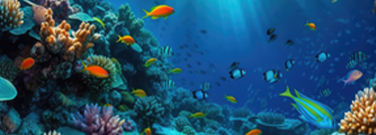Pacific Ocean Is Home to Thousands of New Species

By Christina P. Hooton
It may be fun to speculate about the existence of life on other planets, but luckily you don’t need to travel that far to find new life forms. Over 5,000 species have recently been discovered in a region of the Pacific Ocean called the Clarion-Clipperton Zone (CCZ), an area that spans almost two million square miles between Hawaii and Mexico.
According to a paper published in the journal Current Biology, this mineral-rich area of the ocean floor is home to thousands of marine species that are new to science—and potentially many more since the area is relatively understudied.
An Ocean of Data
Synthesizing more than 100,000 records drawn from previous research expeditions, scientists developed the first exhaustive list of species known to exist in the CCZ. Of the 5,580 species observed in this study, 5,142 species are new and haven’t been formally named and described, and little is known about them. Only six of the species scientists are familiar with are documented in other parts of the ocean.
The study focused on benthic metazoans, or multicellular animals living at the bottom of the ocean, a place of extreme cold and darkness with very little food. Scientists join research cruises to send remote-controlled vehicles over 13,000 feet below the ocean surface to study and collect these specimens, watching by video from the boat.
Most species in the CCZ are arthropods, worms, members of the spider family, and echinoderms. These alien-like creatures, some brightly colored with spiny tentacles like the deep-sea starfish and others eerily translucent and blob-like, such as the gummy squirrel, seem perfectly happy with life under the sea.
A Threat to Biodiversity
The CCZ is not only attractive to the sea creatures who live there. It is currently being considered for deep-sea mining expeditions because of its high volume of mineral deposits. Small rocks called nodules about the size of a potato fill the seafloor and are rich with minerals such as cobalt, manganese, nickel, copper, and zinc. These minerals are valuable because they can be used to develop electric vehicle batteries and renewable energy.
“We are on the eve of some of the largest deep sea mining operations potentially being approved,” study co-author Adrian Glover, a researcher at the Natural History Museum in London, said in a statement. “It is imperative that we work with the companies looking to mine these resources to ensure any such activity is done in a way that limits its impact upon the natural world.”
Some worry that the underwater vehicles used for mining could crush or disturb marine animals and release sediment that may be filled with toxic heavy metals. Until the full impact on biodiversity is understood, scientists are urging caution to help protect these spectacularly unique species.
Discussion Questions
- What other ecosystems or areas of the world are relatively understudied?
- Why is it so important to preserve the biodiversity of the ocean and other ecosystems?

